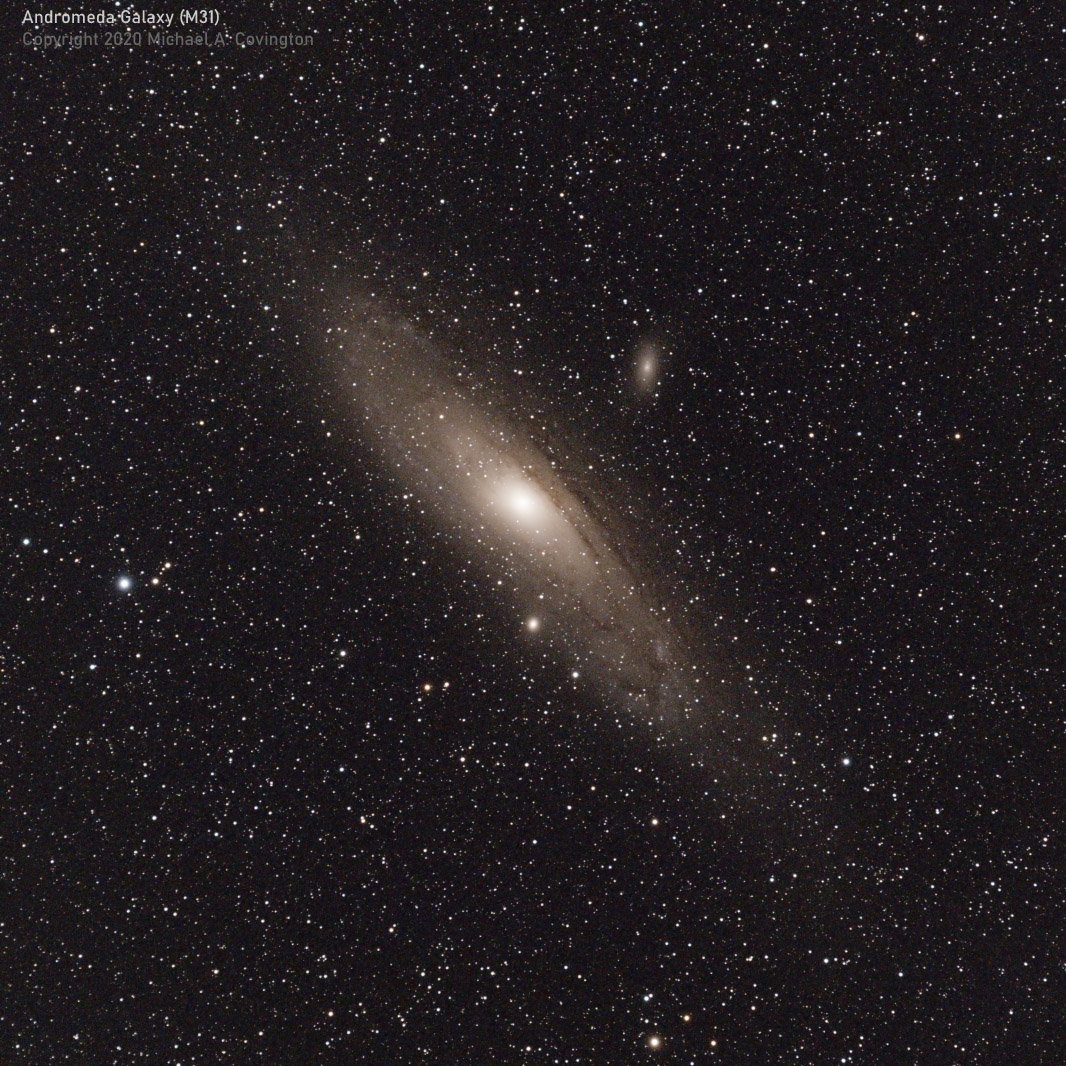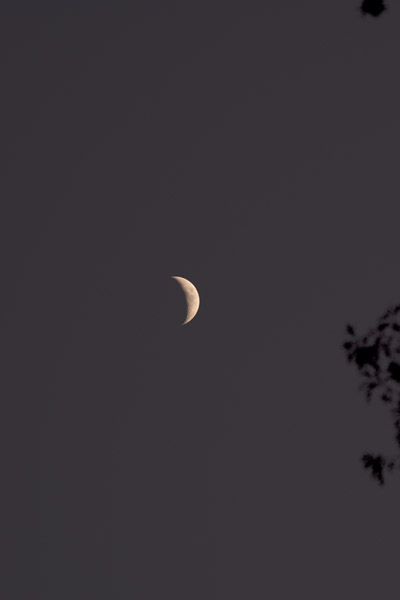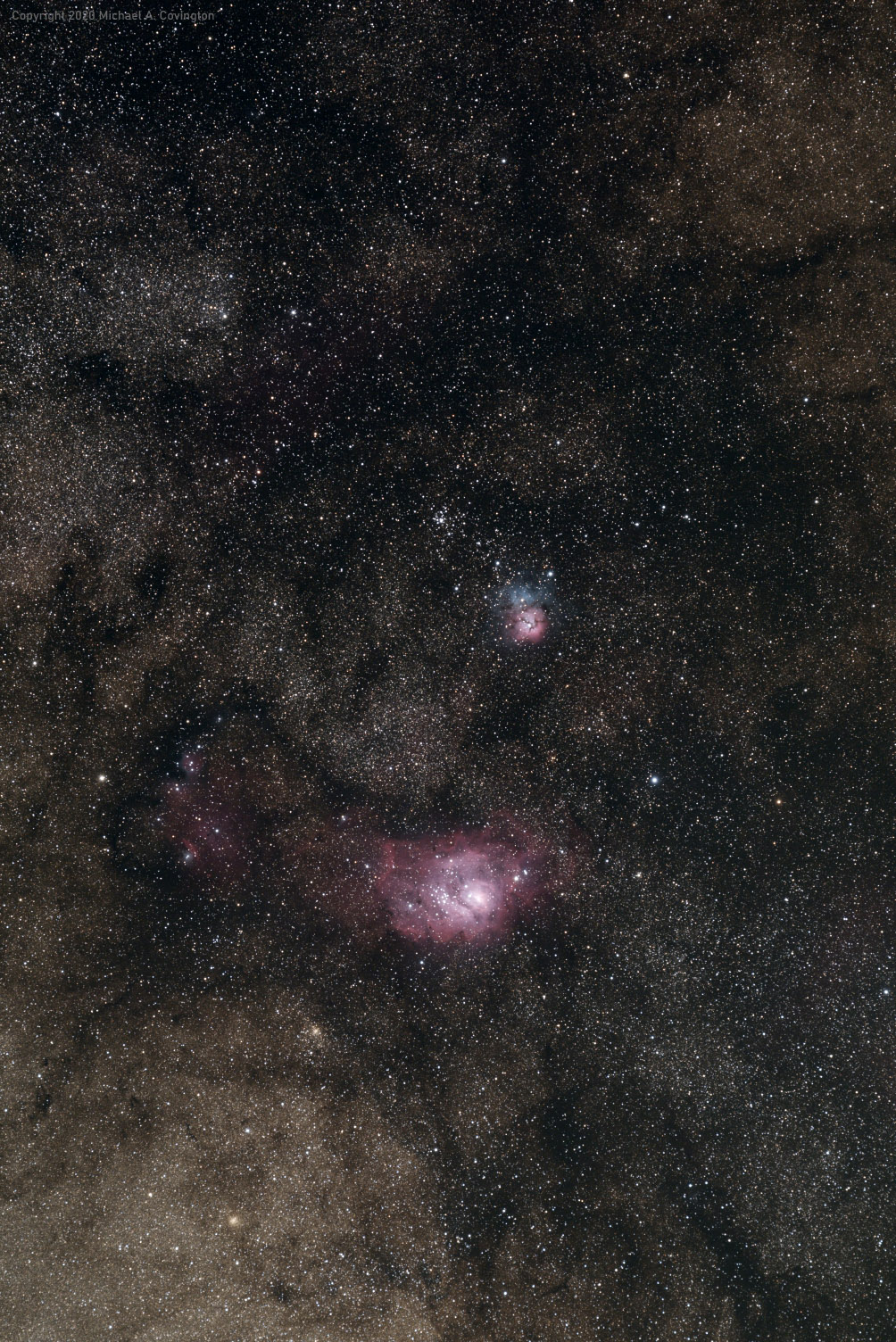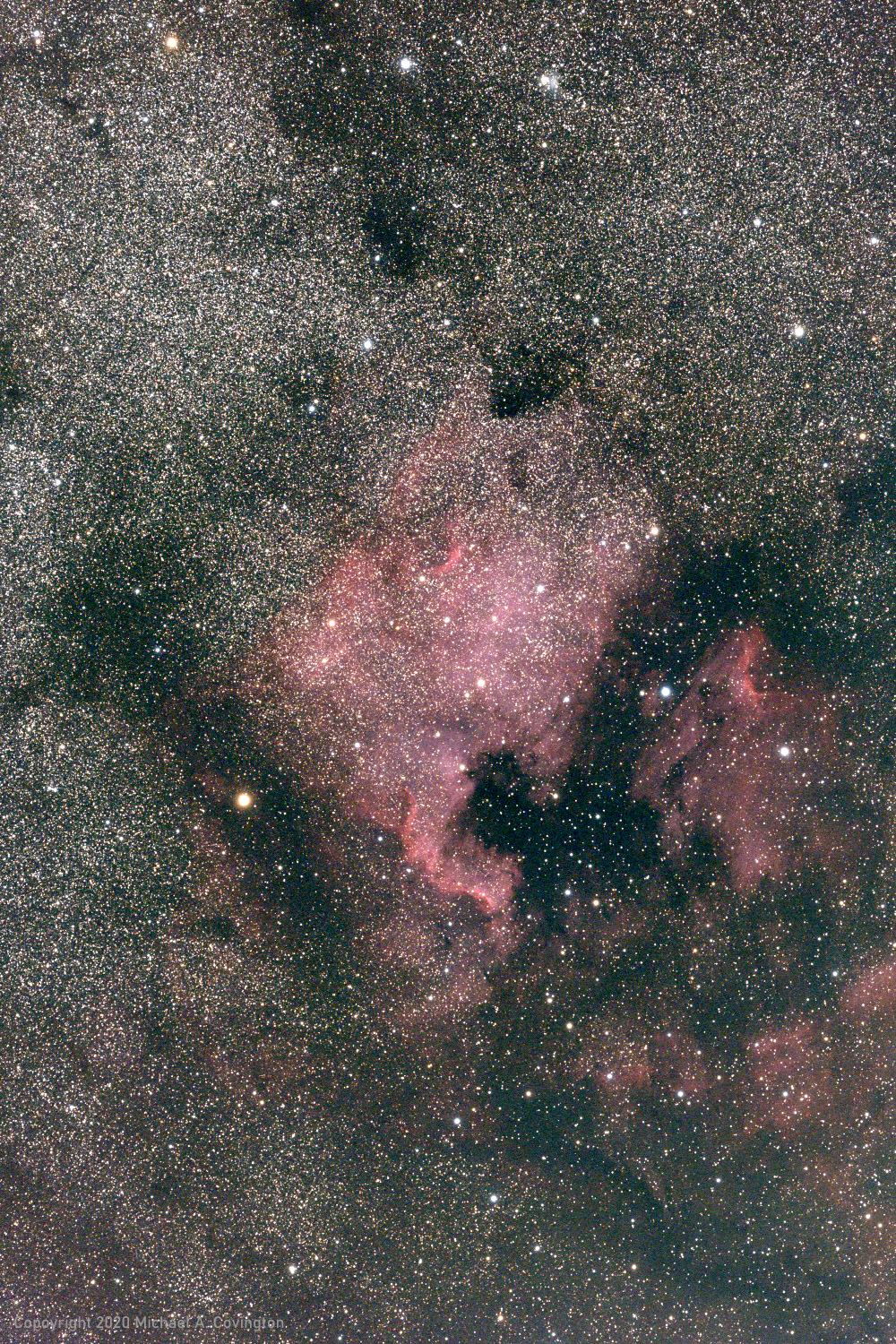2020
September
25
|
The Andromeda Galaxy
Excellent optics can make up for a lot of other problems.
I didn't expect much from this picture, which I took in town while
calibrating some guiding software.
But as you can see, it came out very well.
All the more so when you consider that this is the central portion of
a picture taken with a 200-mm telephoto lens.
|
2020
September
19
|
Ginsburg on individuals vs. collectives
One of the most subtle but important insights expressed by the
late Ruth Bader Ginsburg (may she rest in peace) was in the
Virginia
Military Institute case, where she wrote the majority opinion.
As she put it, "generalizations
about 'the way women are,' estimates of what is appropriate
for most women, no longer justify denying opportunity to
women whose talent and capacity place them outside the
average description. Notably, Virginia never asserted
that VMI's method of education suits most men."
Women's careers were terribly held back by the collective thinking that was
popular in the mid-20th century. "Most women don't want to do this" or
"Most women can't do this" turned into "Women shouldn't be allowed to do this."
The same reasoning was applied to racial minorities and other segments of
society. Every member of a group was expected to have the same talents and tastes.
I have blogged about this in the context of
utilitarian vs. deontological ethics.
Do you do "the most good for the greatest number" or do you do what is right in each individual case?
Utilitarians can justify treating small groups badly in order to treat larger groups better.
Deontologists can't.
Permanent link to this entry


|
2020
September
18
|
111111 years old
A quick note, since things have been busy.
As of September 14, I am 111111 years old, at least if you use binary numbers.
My present from Melody, which I picked out myself, is a new-old-stock
Sheaffer italic pen (vintage 1982 or so) that will be an honored replacement
for my two all-time favorite pens: a Sheaffer Targa that my mother gave me
in 1980 (which is well and truly worn out, though still usable) and a Sheaffer
Triumph (italic) that I bought in England in 1976. The latter is still in good
condition (although, like the Ship of Theseus, not one part of it is original!);
I want to give it a dignified retirement and not subject it to the risks of daily use.
So here we have an italic point (like the Triumph) in a Targa body, a product
I didn't know Sheaffer had ever made.
I recommend Peyton Street Pens.
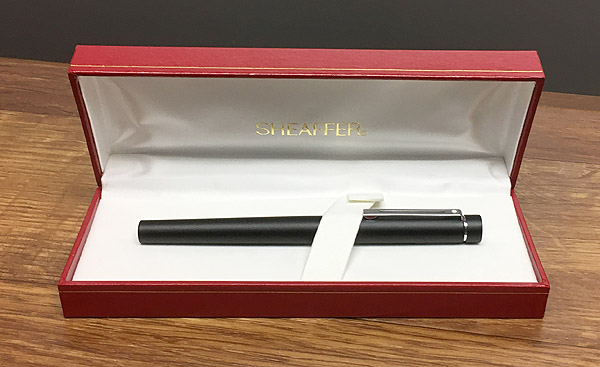
Today (September 18) is the 47th anniversary of the day I flew back from Rome,
concluding a trip around the world; the 19th was my first day at the University of Georgia
as a student. Today I cannot even safely go on campus; the University is open, with
health precautions, but random sampling suggests that about 8% of the population is infected
with COVID, which is much more dangerous for people my age than for students.
The rate of infection in Clarke County seems to have peaked on September 3, but there's
a trick to it — some are saying that students who don't feel seriously ill simply
aren't going for a test when they have symptoms, because they don't want to be quarantined.
Elsewhere in Georgia, we're well past the second peak of the pandemic.
Other trivia: A trip to the eye doctor yesterday explained why none of my eyeglasses give a
sharp view through the right eye. The astigmatism has gone from 0.75 to 0.00. I actually think
0.75 a couple of years ago
was a fluke, as earlier measurements had been around 0.5 and decreasing.
So I am eagerly awaiting new glasses... and sunglasses... and laptop/reading glasses (+1.75)...
and big-screen computer glasses (+1.25). (The first from Lenscrafters locally,
the rest from Zenni. Many optical shops are shut because of the pandemic.)
It will take a couple of weeks.
In the meantime my left eye is doing more of the work.
I am well aware that in optometry, astigmatism is any deviation from circular symmetry,
not just the classical lens aberration that goes by that name,
and it could well be that part of the lens in my eye is astigmatic and part isn't.
That's the impression I get when looking at distant point sources out of focus, and
it would explain inconsistent results over the years.
In any case, I'm definitely going to have better vision with the new glasses,
and I'm looking forward to it.
What this implies for astronomy is that I apparently won't need Tele Vue eyepiece astigmatism
correctors any more. Search for "DioptRx" in this blog to find out what those are.
Finally, last night we watched live webcam images as it looked like Mount Wilson Observatory
was about to burn down. Actually, we were looking at a backfire that had been set on the rim
of a canyon south of the observatory, but we didn't know that. Thank goodness the observatory
is safe this morning.
Permanent link to this entry


|
2020
September
11
|
Jupiter and Saturn in detail
I got excellent images of Jupiter and Saturn last night (Sept. 10) even though they were
low in the sky. Somehow, this time the turbulence of the air did not blur them much, but
rather made them lurch back and forth sideways, making me think my mount was having a problem
tracking them. (If so, it did not have a problem tracking anything else.)

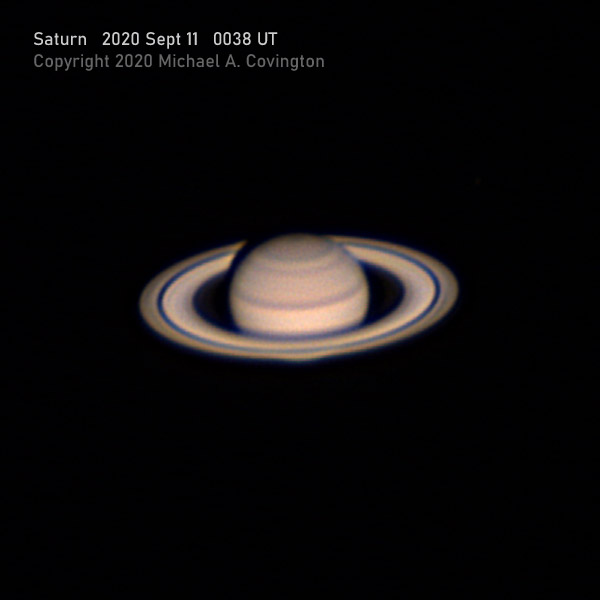
Each of these is the best 33% of some thousands of video frames.
Celestron C8 EdgeHD, 3× focal extender, ASI120MC-S camera,
stacked with Autostakkert and sharpened with Registax.
Permanent link to this entry
9/11
We continue to mourn the victims of September 11, 2001, and honor the heroes, but my
word to my fellow citizens today is something different:
Don't forget that today is not September 11, 2001. That was nineteen years ago.
We are no longer in the immediate aftermath of the attacks.
We may have fixed our consciousness and our policies on them for too long.
Permanent link to this entry


|
2020
September
9
|
Barnard's E
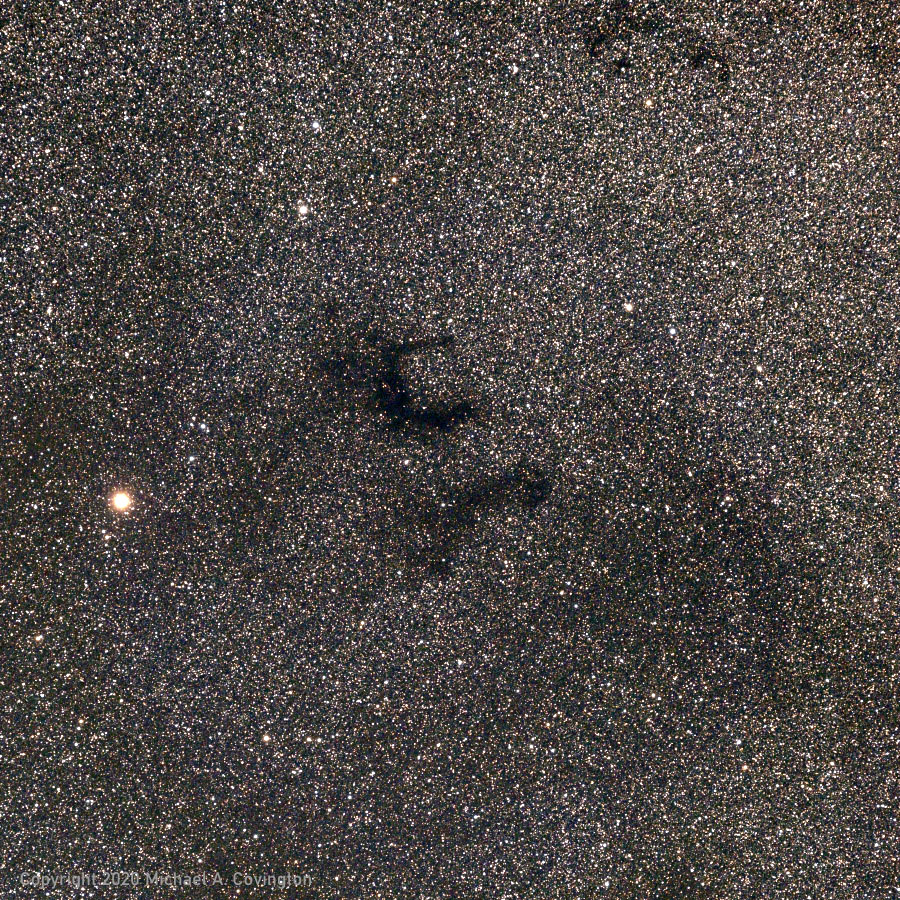
This dark nebula, next to the star Tarazed in Aquila, is called "Barnard's E" because
it was discovered by E. E. Barnard and is shaped like the letter E.
It's a cloud of dust obscuring the bright Milky Way behind it.
Askar 200-mm lens at f/4, stack of 20 2-minute exposures, Nikon D5500 (H-alpha) at ISO 400,
taken in my driveway using the GEM45 with PEC and no autoguiding.
I'm still at the stage of what I call "teaching a new dog old tricks," replicating earlier
successes using newer equipment. I'll move into more original astrophotography soon.
Permanent link to this entry
Checking in on Jupiter
This year we're not getting a good view of Jupiter from Georgia because it's in the part
of its orbit that the earth's northern hemisphere is tilted away from.
Accordingly, it doesn't rise very high in our night sky, and when I'm not dodging trees,
I'm looking at Jupiter low in the sky, through a lot of unsteady air.
Saturn presently has the same problem. Mars, however, is better placed, and in a
couple of months I should have good pictures of it.

Here's a mediocre view of Jupiter from last night. It shows the Great Red Spot, the satellite Io,
and the shadow of the satellite. It's not unlike the view of Jupiter through a somewhat
smaller telescope. It's also a good example of a picture that is not great astrophotography
(not very sharp relative to what the equipment should deliver) but is good astronomy
(because it accurately records features and events of interest).
Permanent link to this entry


|
2020
September
7
|
The Lagoon and Trifid Nebulae
Last night I finally got to test the Askar 200-mm f/4 lens under a dark sky,
at Deerlick. Here's a stack of twenty 2-minute exposures of the Lagoon and Trifid Nebulae
(the lower and upper ones respectively, M8 and M20). Above M20 is the star cluster M21.
|
2020
September
6
(Extra)
|
Why astronomical pictures need special processing
People sometimes ask why we "process" our astronomical photographs rather
than just take what comes out of the camera.
There are three main reasons:
(1) To correct for known imperfections of the lens and sensor. That's what flat fields and dark frames
are for. Astrophotography is so sensitive that we gain a lot by mathematically removing measurable
imperfections of the sensor and the optics.
(2) To combine ("stack") many short exposures into one long one.
(3) To get the right brightness and contrast. That is called stretching and here's an example
of what it does:

Now why do pictures need stretching? Is it even fair? Are we being deceptive by not giving you what
comes out of the camera?
The answer is that all the digital pictures you've ever seen are stretched. Your computer screen doesn't
use the same brightness scale as the camera sensor. Stretching is necessary, and is done for you automatically
when the camera makes a JPEG file.
But the camera doesn't know how to stretch astronomical images correctly. Many of them are underexposed,
and all of them have light from the sky background (city lights, etc.) that needs to be removed.
That's why we always adjust the stretching manually.
Giving you the unaltered image straight from the camera isn't an option. Without stretching, you wouldn't
see anything in it, and you wouldn't see much in even an unstretched daytime photo. Remember how pictures on film
were developed into negatives and then printed 50 years ago? The person or machine making the print had
to make decisions about the brightness and contrast of the picture. Same thing.
Permanent link to this entry


|
| |
Would you believe I took this picture in town, under a slightly hazy sky
in which the Milky Way was barely visible?
Digital image processing makes it possible to separate the real sky from the murk.
I used the 200-mm Askar lens at f/4 and my Nikon D5500.
(Note the sharp stars all the way to the corners. Most telephoto lenses
don't perform this well.)
Tracking was provided by my iOptron GEM45 mount with PEC playback enabled
but without autoguiding.
This is a stack of sixteen 2-minute exposures, every one of which was well tracked.
Permanent link to this entry
Moon and Mars
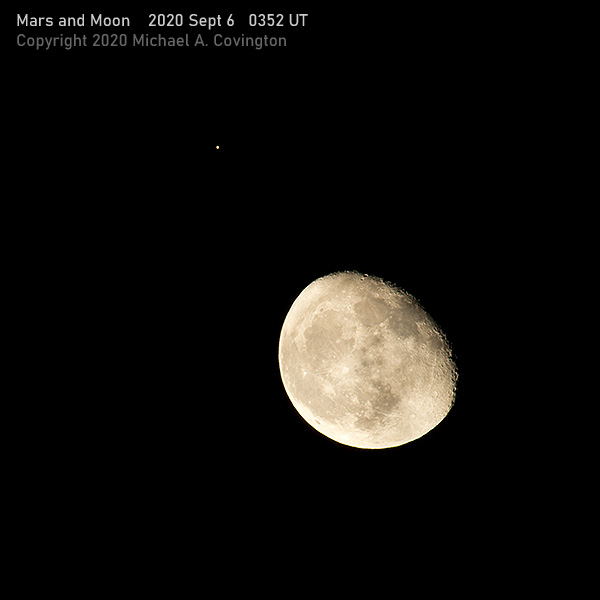
Mars and the moon were close together in the sky (not, of course, close together
in space) near midnight on the night of September 5-6, and after waiting a long
time for a suitable hole in the clouds, I got this picture.
To the eye, Mars looked brighter than in the picture, and the pairing was a striking sight.
Canon 60Da, Canon 300/4 telephoto lens, 1/40 second, f/8, ISO 100, fixed tripod.
Permanent link to this entry
What the iPolar can see
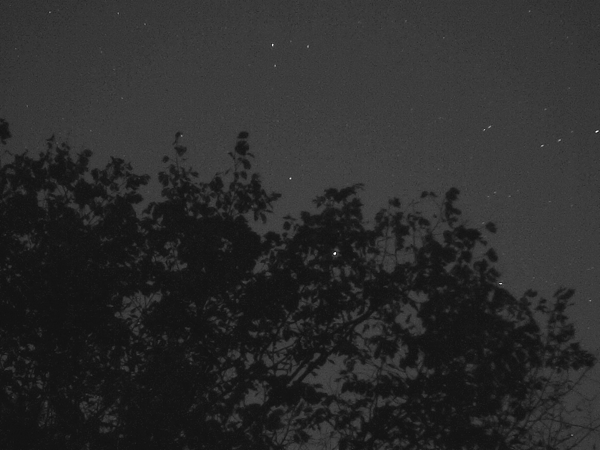
My iOptron mount performs polar alignment using a built-in camera that is aligned
with the polar axis. Its software, which I run on a laptop,
looks at a field of stars near Polaris and compares it to a
built-in star map.
To my delight, it doesn't actually have to be able to see Polaris.
Quite a bit of the field of view can be blocked off.
Last night I took a picture through it using Sharpcap (another software package) in order
to determine its field of view, which is slightly more than 8 by 11 degrees.
It gave an excellent polar alignment with only this view of the pole.
I can confirm that it works equally well if Polaris (the brightest star in this picture) is completely
blocked from view, as long as there are enough other stars.
Permanent link to this entry


|
2020
September
4
|
Askar 200-mm f/4 apochromatic astrograph
For the past few weeks, on the rare occasions that weather permitted, I've been
testing an Askar ACL200 200-mm f/4 telephoto lens
designed for astrophotography.
The manufacturer lent it to me for testing, and I liked it so much I bought it from them.
I'm still planning to write a published review of it, so I won't give a detailed review
here. But I'll show you that it's serving me well...
|
2020
September
3
|
Checking in on the planets
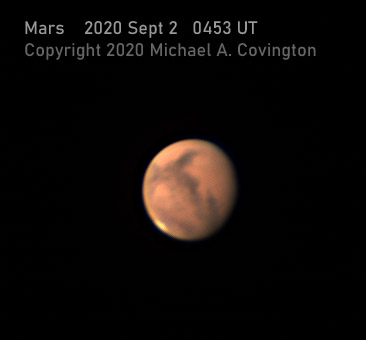
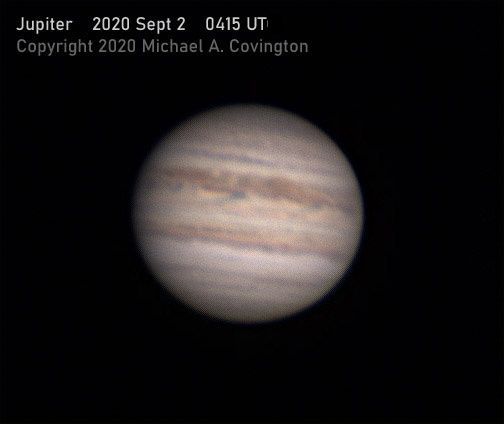
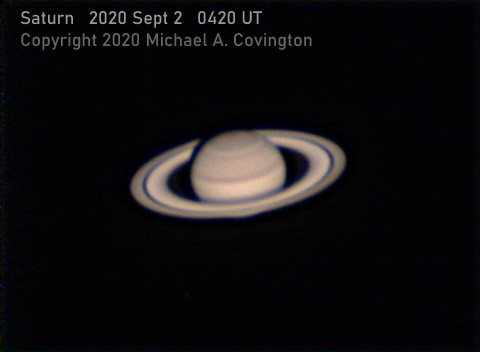
On the evening of September 1 I gave my CGEM mount a farewell cruise; it is being
sold now that I have the GEM45. Using the C8 EdgeHD and a 3x extender, I got these
images of three planets, all of which were quite low in the sky — which should
have blurred the image, and did, but not as badly as I expected because the air
was unusually steady.
Permanent link to this entry


|
2020
September
2
|
50th anniversaries
This is the time of my life when 50th anniversaries of important events
come fast and furious, and I've let two of them slip by.
One is that Friday, August 28, was the 50th anniversary of my first day at
Valwood School.
A few years ago I wrote a memoir,
Confessions of Valwood's First Computer Geek,
to which I refer you.
I am delighted to have been able to share this on Facebook with at least two
students and one teacher who were there on that day.
And as I've said elsewhere, in many ways the first day of ninth grade there
was the beginning of my adult life — not that I was an adult, but that things
were set in motion that have continued ever since.
(Arguably, my linguistics career started with the first day of Latin class.)
The long, lonely summer after eighth grade was over, and from then on, for the rest
of my life, I have had regular opportunities to do things I am interested in,
with congenial people.
[Added 2023:] High school was far from perfect,
of course, but it was a big step forward.
The first day of college was when I really felt I had found my home.
(Details: When I wrote the memoir, I had forgotten that school actually started
in August, not September. And August 28 was a Friday that year and also this year;
the calendar for 2020 after Leap Year Day happens to be the same as for 1970.)
The other anniversary is the arrival of my first serious telescope on September 1, 1970.
It was a Criterion RV-6, and I hope to write more about it later.
There are still enthusiasts who maintain, restore, and use RV-6's.
It's a 6-inch f/8 reflector, very good for visual astronomy, noted for its high-quality
optics, low price, and odd eyepieces (everybody, including me, got a different set of
eyepieces very early on). It's not very suited for astrophotography, and I don't want
one today; when I got back into astronomy in 1980 after a lapse, I chose a Celestron 5, not
another RV-6, because it's much more portable and versatile.
Permanent link to this entry
Facebook — boon or headache?
I have reduced my time on Facebook to brief check-ins, and it's like getting rid of a
headache. Conversations involving any difference of opinion had become impossible —
and people have strong and strange opinions about what ought to be simple questions of fact.
For example, someone said the other day that the false positive rate on COVID tests was
much higher than everyone thought. Interesting, I said, so why haven't we heard more about
this? I would have expected it to be all over the medical journals, or at least a topic
of conversation among doctors who are treating patients.
The answer that I got was a gradually unfolding
tirade about how we're not hearing about this because some organization
is controlling all the medical journals and all the doctors,
even their casual conversations, and "qualifications mean nothing"
so I should just ignore everybody who says anything different. Huh?
Such things are a tremendous waste of time. As we deal with months of COVID frustration
combined with ramping up to the election, many of my more intelligent friends have
become blowhards, telling the world at length things we've already heard, while less
wise individuals are swallowing bizarre conspiracy theories and holding them unquestioningly.
Not only do they say strange things, they
get angry when asked what they mean.
I rely on Facebook to stay in touch with relatives, good friends, and many fellow amateur
astronomers. So I can't leave it completely. But I am limiting my time and avoiding any
discussion that might be pounced on by conspiracy theorists.
Permanent link to this entry
COVID update
I'll write more about this later, and I won't mention it on Facebook, because there,
in many people's minds, there are no facts, only political agendas, and any
statement of fact has to be attacked as a political agenda.
Briefly: After the initial bump in COVID cases that I tracked so closely in March and April,
Georgia had a slower but bigger bump in July, which is now subsiding.
I now think the first bump was a reflection of the surge in the Northeast, and the second one
was associated with Florida and summer vacations.
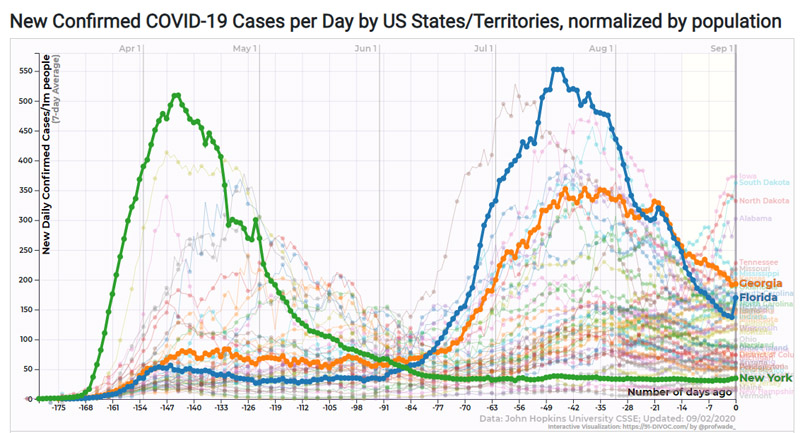
Crucially, even though the second bump is taller, the first bump was much more alarming
because it was fueled by a much smaller number of already-existing cases.
That means the spread rate (Rt) was much higher in March than in July.
Also, there was much less testing in March than in July, so the first bump was
bigger than it looked.
The summer bump is subsiding nicely everywhere but Athens, which is having a spike presumably because
of the returning University students.
From here on, I think we're going to see rolling hot spots, localized outbreaks.
We've reached a sustainable way of life where people wear masks, crowds are restricted, and
the virus is gradually getting under control. Our biggest health hazard is
the blowhards who say "nobody can
make me wear a mask" or "the virus is a hoax."
That's another reason for avoiding Facebook. While Melody has two extended family members
who have almost died of COVID, I don't want to be around kooks who say there is no such thing
and no precautions are needed.
Permanent link to this entry


|
|
|
This is a private web page,
not hosted or sponsored by the University of Georgia.
Copyright 2020 Michael A. Covington.
Caching by search engines is permitted.
To go to the latest entry every day, bookmark
http://www.covingtoninnovations.com/michael/blog/Default.asp
and if you get the previous month, tell your browser to refresh.
Portrait at top of page by Sharon Covington.
This web site has never collected personal information
and is not affected by GDPR.
Google Ads may use cookies to manage the rotation of ads,
but those cookies are not made available to Covington Innovations.
No personal information is collected or stored by Covington Innovations, and never has been.
This web site is based and served entirely in the United States.
In compliance with U.S. FTC guidelines,
I am glad to point out that unless explicitly
indicated, I do not receive substantial payments, free merchandise, or other remuneration
for reviewing or mentioning products on this web site.
Any remuneration valued at more than about $10 will always be mentioned here,
and in any case my writing about products and dealers is always truthful.
Reviewed
products are usually things I purchased for my own use, or occasionally items
lent to me briefly by manufacturers and described as such.
I am no longer an Amazon Associate, and links to Amazon
no longer pay me a commission for purchases,
even if they still have my code in them.
|
|




